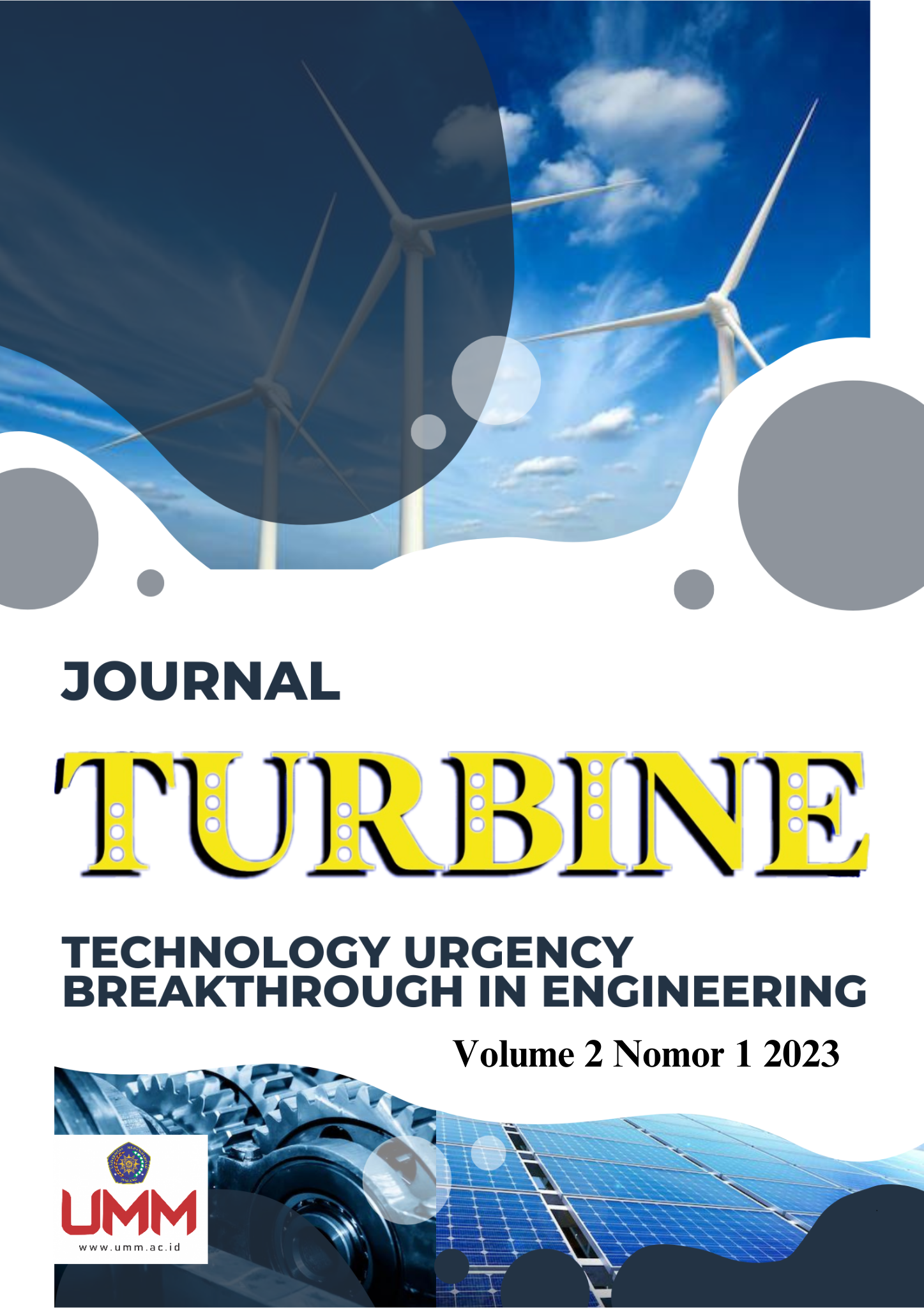Prototype Mesin Pecacah Pelepah dan Daun Kelapa Sawit Sebagai Pakan Ternak Alternatif Pengganti Hijauan
Keywords:
Rancang Bangun, Mesin Pencacah, Limbah Pelepah Sawit, Mata PisauAbstract
Abstract
Oil palm waste is the residue from the main product of oil palm trees that is not utilized, oil palm itself can produce solid waste in the form of stems, empty fruit bunches, shells, fiber (coir) and fronds. In one oil palm tree can produce 40 to 50 fronds within one year, fronds and fronds of oil palm are obtained from the rest of the crop and also when caring for the tree. The purpose of this research is to make and test a prototype chopper machine so that it can utilize and reduce waste of palm fronds and leaves. The driving motor on this prototype uses a 2 hp electric motor with 1450 rpm rotation, pulley 1 which is on a 4 inch electric motor and pulley 2 which is on a 6 inch blade shaft, then for the belts used there are 2 pieces with size B-55. Calculations made during the design process of the prototype of the palm frond and leaf counter machine were Pully Circumferential Speed, Pully Circumferential Force, Belt Tension, Maximum Belt Tension, Number of Belt Rotations, Number of Belts, Belt Age and calculation of speed and torque on the blade shaft. The ingredients that are chopped are fronds and freshly cut or wet oil palm leaves. The count produced by the prototype was 206 kg/hour with an average of 5 repetitions. For prototype yield, the average yield produced from 5 repetitions was 94.41%, and the chopped results for palm leaves had a length of 20-40 mm.
Abstrak
Limbah sawit merupakan sisa dari produk utama pohon kelapa sawit yang tidak termanfaatkan, kelapa sawit sendiri dapat menghasikan limbah padat berupa janjang, tandan kosong, cangkang, fiber (sabut) dan pelepah. Dalam satu pohon kelapa sawit dapat menghasilkan 40 hingga 50 pelepah dalam waktu satu tahun, pelepah dan daun kelapa sawit didapatkan dari sisa hasil panen dan juga pada saat melakukan perawatan pohon. Tujuan dari penelitian ini adalah membuat serta menguji prototype mesin pencacah agar dapat memanfaatkan serta dapat mengurangi limbah pelepah dan daun kelapa sawit. Motor penggerak pada prototype ini mengunaka motor listrik 2 hp dengan putaran 1450 rpm, pully 1 yang berada dimotor listrik berukuran 4 inch dan pully 2 yang berada diporos mata pisau berukuran 6 inch, kemudian untuk belt yang digunakan berjumlah 2 buah dengan ukuran B-55. Perhitungan yang dilakukan saat proses perancangan prototype mesin pencacah pelepah dan daun kelapa sawit ialah Kecepatan Keliling Pully, Gaya Keliling Pully, Tegangan Belt, Tegangan Maksimum Belt, Jumlah Putaran Belt, Jumlah Belt, Umur Belt serta perhitungan kecepatan dan torsi pada poros mata pisau. Bahan yang dicacah ialah pelepah dan daun kelapa sawit yang baru di potong atau basah. cacahan yang dihasilkan prototype yaitu 206 kg/jam dari rata-rata hasil pengulangan sebanyak 5 kali. Untuk rendemen prototype rata-rata yang dihasilkan dari 5 kali pengulangan yaitu sebesar 94,41 %, dan hasil cacahan yang dihasilkan untuk daun kelapa sawit memiliki panjang 20-40 mm.
Downloads
References
R. H. Pranata and Z. Arico, “Pemanfaatan Limbah Kebun Pelepah Kelapa Sawit (Elaeis guuinensis Jacq) Sebagai alternatif Pakan Bernilai Gizi Tinggi,” Jurnal Biologica Samudra, vol. 1, pp. 17–24, 2019.
M. Haq, S. Fitra, S. Madusari, and D. I. Yama, “Potensi Kandungan Nutrisi Pakan Berbasis Limbah Pelepah Kelapa Sawit Dengan Teknik Fermentasi,” Jurnal umj, pp. 1–8, 2018.
M. Ariyanti, “Manfaat Pelepah Sebagai Sumber Bahan Organik Pada Media Tanam Kelapa Sawit,” Paspalum: Jurnal Ilmiah Pertanian, vol. 9, no. 1, pp. 77–85, Mar. 2021, doi: 10.35138/paspalum.v9i1.280.
M. A. Hamarung and J. Jasman, “Pengaruh Kemiringan dan Jumlah Pisau Pencacah terhadap Kinerja Mesin Pencacah Rumput untuk Kompos,” 2019.
O. H. Usmayadi, Nurhaida, and D. Setyawati, “KUALITAS BRIKET ARANG DARI BATANG KELAPA SAWIT (Elaeis guineensis Jacq) BERDASARKAN UKURAN SERBUK,” 2018.
R. Sunge, R. Djafar, and E. S. Antu, “RANCANG BANGUN DAN PENGUJIAN ALAT PENCACAH KOMPOS DENGAN SUDUT MATA PISAU 45o,” Jurnal Teknologi Pertanian Gorontalo (JTPG), vol. 4, no. 2, pp. 62–70, 2019.
N. Sari, Iqbal, and M. Achmad, “Uji Kinerja Dan Analisis Biaya Mesin Pencacah Pakan Ternak (Chopper),” Jurnal Agritechno, vol. 11, no. 2, pp. 113–120, Oct. 2018, doi: 10.20956/at.v11i2.115.
A. Rahman, N. Islami, Asnawi, and Safrizal, “Desain Poros Mesin Penghancur Sampah Organik Dengan Daya 1 HP,” Malikussaleh Journal of Mechanical Science and Technology, vol. 5, no. 2, pp. 13–16, 2021.
N. A. Bahry, A. S. Nurrohkayati, S. H. Pranoto, and A. Nugroho, “Pembuatan prototype mesin pencacah sebagai pengolah limbah organik untuk pupuk kompos dan pakan ternak,” TEKNOSAINS : Jurnal Sains, Teknologi dan Informatika, vol. 10, no. 1, pp. 12–19, Jan. 2023, doi: 10.37373/tekno.v10i1.251.
H. Amrin, Jamaluddi p, and L. Lahming, “Rancang Bangun Alat Pemipil Jagung Semi Mekanis Designing Semi-Mechanical Corn Sheller Tools,” jurnal pendidikan teknologi pertanian, vol. 5, no. 2, pp. 25–30, 2019.
T. Firsa, M. Iqbal, and Sulaiman, “Pengembangan Mesin Pencacah Pakan Ternak Sapi bagi Peningkatan Pendapatan Peternak Sapi di Desa Mon Ikeun, Aceh Besar,” Jurnal Pengabdian aceh, vol. 2, no. 1, pp. 41–48, 2022.
N. W. E. Saputro, A. S. Nurrohkayati, and S. H. Pranoto, “Analisis desain mesin pencacah limbah organik sebagai bahan dasar pupuk,” TEKNOSAINS : Jurnal Sains, Teknologi dan Informatika, vol. 9, no. 2, pp. 101–112, Jul. 2022, doi: 10.37373/tekno.v9i2.247.
Downloads
Published
Issue
Section
License
Copyright (c) 2023 Anis Siti Nurrohkayati

This work is licensed under a Creative Commons Attribution-NonCommercial 4.0 International License.




